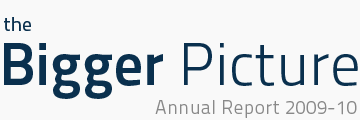Offering music, dance, drama, visual arts and sewing education—in addition to mentoring and homework help after school, on Saturdays and during summer camps—the Rainey Institute serves as an enriching alternative to the risks of unsupervised time for neighborhood children.
More Arts for More Kids
Alumnus Lee Lazar leads inner-city arts organization for kids to success—and a new home
 It will be a bittersweet good-bye for the staff, board and students of the Rainey Institute to leave the building that has housed the organization for the past 106 years. But the move from the run-down structure on E. 55th Street to a new, 23,000-square-foot-facility just four blocks away is a sure sign of success for the modest non-profit—and an opportunity to extend its reach to even more children.
It will be a bittersweet good-bye for the staff, board and students of the Rainey Institute to leave the building that has housed the organization for the past 106 years. But the move from the run-down structure on E. 55th Street to a new, 23,000-square-foot-facility just four blocks away is a sure sign of success for the modest non-profit—and an opportunity to extend its reach to even more children.
What began in 1904 by Eleanor B. Rainey as an organization to help Eastern European immigrants assimilate into American culture morphed in the 1960s into an arts organization for inner-city kids and has provided programming and a safe haven for children in the Hough neighborhood ever since.
Offering music, dance, drama, visual arts and sewing education—in addition to mentoring and homework help after school, on Saturdays and during summer camps—the Rainey Institute serves as an enriching alternative to the risks of unsupervised time for neighborhood children.
Taking the reigns of the institute in 2007 was Lee Lazar, a lawyer-turned-businessman-turned-urban-education-advocate who was charged with catching the organization's business side up with its programmatic offerings. Previous leadership had created a strong internal community, but hadn't focused many efforts externally, and the institute needed more attention in matters of business strategy, development and marketing.
Lazar, who had previously served as the principal of an urban charter school, knew he wanted to focus the rest of his career on helping inner-city kids and had completed the non-profit certificate program at the Mandel Center for Non-Profit Organizations at Case Western Reserve before starting with Rainey.
Coming into the position was a daunting task for Lazar, but one to which he simply couldn't say no. "The way Rainey connected with and helped kids touched a place in my heart," he says.
Relying on the principles he had learned at Mandel, Lazar began by updating the organization's strategic plan and expanding its marketing efforts with advertising and print collateral materials.
In his first two years in the position, Lazar helped Rainey expand its operating budget and student population by 50 percent. But with tuition covering less than 15 percent of operating costs, he knew the organization was overdue to reignite their capital campaign. With thoughtful development tactics, Lazar and the board successfully raised $5 million, even during a stuttering economy, and was able to commit to building the organization's new facility on a plot of land the institute had owned for 10 years but had never before had the resources to use.
Moving into the new location at the beginning of 2011, Rainey Institute will now have double the space of its previous location and will be able to accommodate Lazar's goal of doubling the number of kids served over a five-year period. Those 1,300-some students will be able to use the new facilities' performance space, scenery shop, dance rooms, classrooms and more.
"Yes, we're an arts organization," says Lazar, "but we're not in the business of producing professional artists—even though we sometimes do. We're in the business of helping to produce professional citizens."
See more of the picture: Visit the Rainey Institute website.

